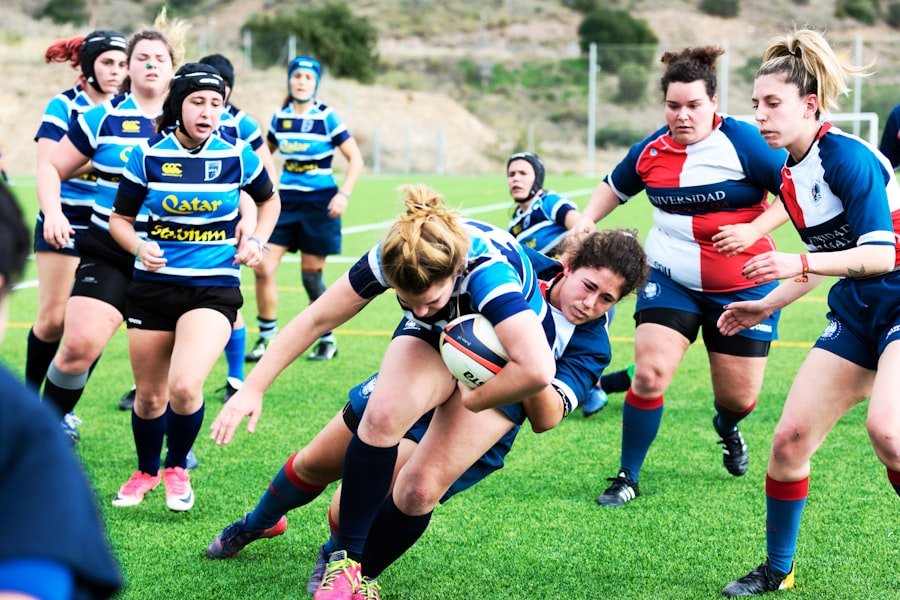
Building a Strong Foundation: Effective Core Workouts for Stability and Strength
The core is often referred to as the powerhouse of the body, and for good reason. It plays a crucial role in maintaining stability and balance, as well as providing support for the spine. Core workouts are essential for building strength, improving posture, and reducing the risk of injuries. Whether you’re an athlete looking to enhance your performance or someone simply wanting to improve their overall fitness, incorporating core exercises into your workout routine is a must.
Key Takeaways
- Core workouts are important for stability and strength
- The core includes multiple muscles with different functions
- Strong core leads to improved posture, balance, and reduced injury risk
- Basic exercises like planks and crunches are effective, but advanced exercises like Russian twists and side planks can provide more challenge
- Equipment-based workouts with medicine balls, stability balls, and resistance bands can add variety and intensity to core workouts.
Understanding the Core: Muscles Involved and Their Functions
The core includes muscles in the abdomen, back, and pelvis. These muscles work together to support the spine, maintain balance, and transfer force between the upper and lower body. The main muscles of the core include the rectus abdominis (the “six-pack” muscles), transverse abdominis (deep abdominal muscles), obliques (side abdominal muscles), erector spinae (back muscles), and glutes (buttock muscles). These muscles not only provide stability but also help with everyday movements such as bending, twisting, and lifting.
Benefits of Strong Core: Improved Posture, Balance, and Reduced Risk of Injuries
A strong core can have numerous benefits for overall health and fitness. One of the most noticeable benefits is improved posture. When the core muscles are strong, they help support the spine and maintain proper alignment, reducing the risk of developing poor posture or back pain. Additionally, a strong core can improve balance and stability, making it easier to perform daily activities and reducing the risk of falls or other injuries.
Furthermore, a strong core is essential for athletes or individuals participating in sports or physical activities. It provides a solid foundation for movements such as running, jumping, or throwing. By improving core strength, athletes can enhance their performance and reduce the risk of injuries caused by poor form or muscle imbalances.
Basic Core Exercises: Planks, Crunches, and Bridges
| Exercise | Duration | Repetitions | Difficulty |
|---|---|---|---|
| Planks | 30 seconds – 2 minutes | 2-3 sets of 10-15 reps | Intermediate |
| Crunches | 30 seconds – 1 minute | 2-3 sets of 10-15 reps | Beginner |
| Bridges | 30 seconds – 1 minute | 2-3 sets of 10-15 reps | Beginner |
When it comes to core workouts, there are several basic exercises that are simple yet effective. Planks, crunches, and bridges are among the most popular exercises that target the core muscles.
Planks are a great exercise for strengthening the entire core. To perform a plank, start by getting into a push-up position with your forearms resting on the ground. Engage your core muscles and hold the position for as long as you can while maintaining proper form.
Crunches are another classic core exercise that targets the rectus abdominis. Lie on your back with your knees bent and feet flat on the ground. Place your hands behind your head and lift your upper body off the ground, engaging your abdominal muscles. Lower back down and repeat for a set number of repetitions.
Bridges target the glutes and lower back muscles while also engaging the core. Lie on your back with your knees bent and feet flat on the ground. Lift your hips off the ground, squeezing your glutes and engaging your core. Hold for a few seconds before lowering back down and repeating.
Advanced Core Exercises: Russian Twists, Bicycle Crunches, and Side Planks
Once you have mastered the basic core exercises, you can progress to more advanced movements that engage multiple core muscles simultaneously. Russian twists, bicycle crunches, and side planks are excellent examples of advanced core exercises.
Russian twists target the obliques and improve rotational strength. Sit on the ground with your knees bent and feet lifted off the ground. Hold a weight or medicine ball in front of you and twist your torso from side to side, touching the weight to the ground on each side.
Bicycle crunches are a challenging exercise that targets both the rectus abdominis and obliques. Lie on your back with your hands behind your head and legs lifted off the ground. Bring your right elbow towards your left knee while extending your right leg out straight. Repeat on the other side, alternating sides in a cycling motion.
Side planks are a great exercise for targeting the obliques and improving core stability. Start by lying on your side with your forearm on the ground and your feet stacked on top of each other. Lift your hips off the ground, creating a straight line from your head to your feet. Hold for as long as you can before switching sides.
Equipment-Based Core Workouts: Medicine Ball, Stability Ball, and Resistance Bands

Using equipment such as medicine balls, stability balls, and resistance bands can add variety and intensity to core workouts. These tools can help target specific core muscles and increase the difficulty of exercises.
Medicine balls can be used for exercises such as Russian twists or overhead slams, which engage the core muscles while also providing an upper body workout. Stability balls can be used for exercises such as ball rollouts or pikes, which challenge the core muscles by adding an element of instability. Resistance bands can be used for exercises such as standing wood chops or seated rows, which target the core muscles while also providing resistance for strength training.
Incorporating Cardiovascular Exercises for a Complete Workout
While core workouts are essential for building strength and stability, it’s important to incorporate cardiovascular exercises into your routine as well. Running, cycling, swimming, or any other form of cardiovascular exercise can complement core workouts and provide additional health benefits.
Cardiovascular exercises improve cardiovascular health by increasing heart rate and improving circulation. They also help burn calories and promote weight loss, which can further enhance core strength by reducing excess body fat. Additionally, cardiovascular exercises improve endurance and overall fitness, making it easier to perform other physical activities.
Creating a Balanced Workout Routine: Frequency, Duration, and Intensity
To create a balanced workout routine that includes core exercises and cardiovascular exercises, it’s important to consider frequency, duration, and intensity. The frequency of your workouts will depend on your fitness level and goals, but aim for at least three to four core workouts per week. Cardiovascular exercises can be done on alternate days or incorporated into your core workouts.
The duration of your workouts will depend on the exercises you choose and your fitness level. Start with shorter workouts and gradually increase the duration as you become more comfortable and stronger. Aim for at least 30 minutes of cardiovascular exercise per session.
The intensity of your workouts should be challenging but manageable. Push yourself to work hard during each workout, but listen to your body and avoid overexertion or pushing through pain. Gradually increase the intensity of your workouts over time as you become stronger and more fit.
Common Mistakes to Avoid: Overtraining, Poor Form, and Neglecting Other Muscle Groups
When it comes to core workouts, there are a few common mistakes that should be avoided. One of the most common mistakes is overtraining the core. While it’s important to work the core muscles regularly, overtraining can lead to muscle imbalances and increase the risk of injuries. Allow for rest days between core workouts to give your muscles time to recover.
Another common mistake is poor form during exercises. It’s important to maintain proper form throughout each exercise to ensure that you are targeting the correct muscles and reducing the risk of injuries. If you’re unsure about proper form, consider working with a personal trainer or watching instructional videos to learn the correct technique.
Lastly, it’s important not to neglect other muscle groups when focusing on core workouts. While the core is important for overall stability and strength, it’s equally important to work other muscle groups such as the legs, arms, and back. Neglecting other muscle groups can lead to muscle imbalances and limit overall fitness.
Building a Strong Foundation for a Healthier and More Active Lifestyle
In conclusion, core workouts are essential for building a strong foundation for a healthier and more active lifestyle. By understanding the core muscles, incorporating a variety of exercises, and avoiding common mistakes, individuals can improve their core strength, posture, and overall fitness. Whether you’re a beginner or an advanced exerciser, there are core exercises suitable for every fitness level. So start incorporating core workouts into your routine today and reap the benefits of a strong and stable core.
FAQs
What is a core workout?
A core workout is a set of exercises that target the muscles in the abdomen, lower back, hips, and pelvis. These exercises help to strengthen and stabilize the core muscles, which can improve posture, balance, and overall physical performance.
Why is a strong core important?
A strong core is important for several reasons. It helps to improve posture, balance, and stability, which can reduce the risk of falls and injuries. It also supports the spine and helps to prevent back pain. Additionally, a strong core can improve athletic performance and make everyday activities easier.
What are some examples of core exercises?
Some examples of core exercises include planks, crunches, Russian twists, bicycle crunches, leg raises, and bird dogs. These exercises can be done with bodyweight only or with the use of equipment such as stability balls or resistance bands.
How often should I do core workouts?
It is recommended to do core workouts at least 2-3 times per week. However, the frequency and intensity of the workouts can vary depending on individual fitness goals and abilities.
Can core workouts help me lose belly fat?
While core workouts can help to strengthen and tone the abdominal muscles, they are not a guaranteed way to lose belly fat. To lose fat in the abdominal area, a combination of regular exercise, a healthy diet, and overall weight loss may be necessary.


















